A killer sketchbook title page can make every art session feel like an adventure. Think “This Sketchbook Belongs To” with bold names, a hand-drawn selfie, or even wild doodles of favorite snacks. Go for a splashy motto, a funny quote with illustrations, fantasy-inspired borders, or a collage of magazine cutouts. Add color swatches, retro scrapbook vibes, or quirky personal icons. Challenge trackers and artsy patterns jumpstart creativity. Want even more awesome title page ideas and tips? Stick around.
Key Takeaways
- Create a vibrant self-portrait or “Meet the Artist” page to introduce your style and personality.
- Design a collage title page using magazine snippets, photos, and textured paper for visual interest.
- Feature a favorite inspirational quote with creative hand-lettering and personalized doodles or illustrations.
- Test art supplies with a colorful swatch page to showcase mediums and create a handy color reference.
- Set the sketchbook’s tone by illustrating your art goals or creative motto with bold layouts and themed decorations.
This Sketchbook Belongs To
A sketchbook’s first page isn’t just blank paper—it’s like a handshake or a “hello” in book form, welcoming everyone who opens it. This is where the magic of the “this sketchbook belongs to” page kicks in. Instead of just scribbling your name like it’s roll call, think of it as your chance to shine!
You get to write your name in big, bold letters or quirky little doodles—whatever feels most like you. Some artists turn their title page into a mini-gallery, filling it with objects, colors, or symbols that totally scream “them.”
Collages, cute stickers, painted borders—go wild! If your sketchbook skips a title page, don’t worry. Create your own, and maybe scroll Pinterest for a spark of inspiration!
Welcome to My Sketchbook
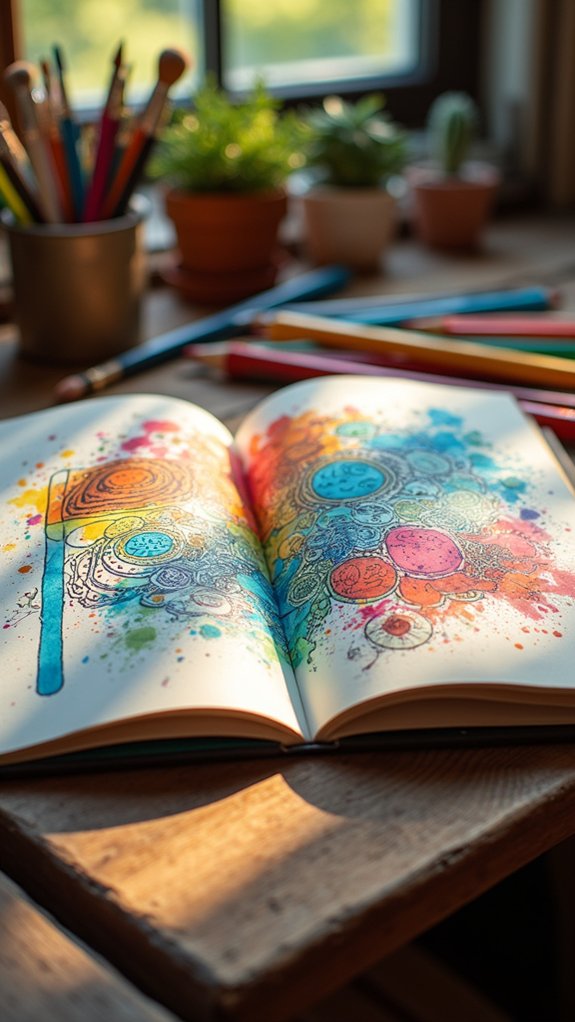
Before even flipping to the sketchiest doodles or epic art explosions, the “Welcome to My Sketchbook” page sets the vibe.
It’s like rolling out a red carpet for your ideas—and hey, everyone’s invited! This page isn’t just a fancy sign; it’s a launchpad packed with personality and creative ideas.
Artists can have tons of fun by making a bold statement with cool lettering, playful doodles, or even their first drawing that teases what’s ahead.
Want some attention-grabbing tips? Try this:
- Write a short, friendly “welcome to my sketchbook” note.
- Doodle quirky characters, plants, or your favorite things around the border.
- Add a list of art goals and empty circles—so you can check them off as you go.
Let the adventure begin!
Meet the Artist Self-Portrait
After rolling out the sketchbook welcome mat, it’s time to put a friendly face to the art. The “Meet the Artist Self-Portrait” sketchbook page is the perfect place to experiment and show off your true colors—literally!
You could sketch yourself as a superhero holding a pencil or doodle your head full of swirling ideas. Don’t forget to toss in some fun facts, like your favorite color (chartreuse, anyone?), your hobbies, or the first letter of your name in bold style.
The best part? You don’t need a ton of writing—a few doodles, key words, and quirky icons say it all. This page isn’t just an intro; it sets the vibe.
Your creative journey starts here, with you as the hero!
My Artistic Motto or Manifesto
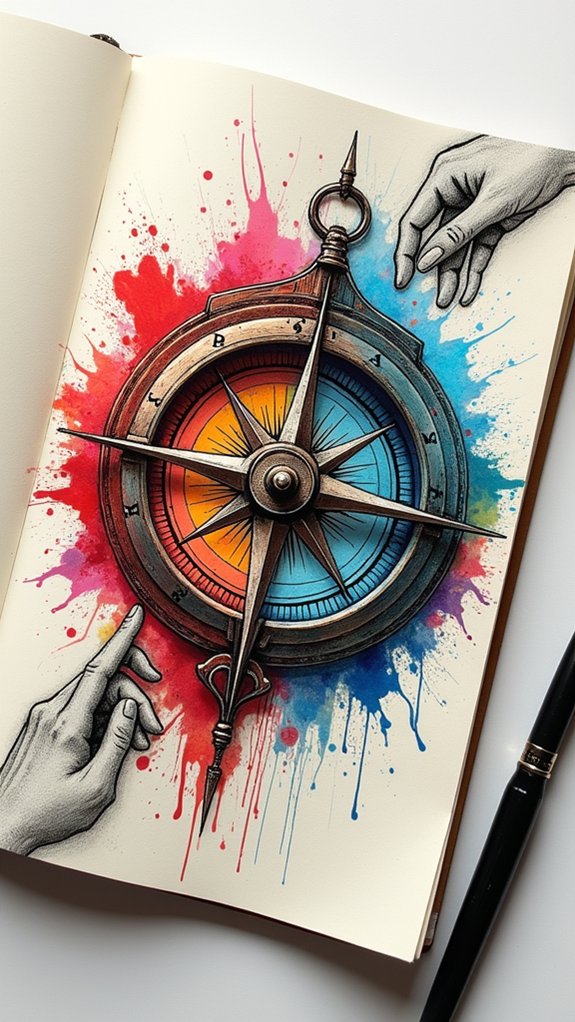
Writing an artistic motto or manifesto on your title page is a bold way to spell out what matters most to you as an artist.
This is all about putting your creative core values into words and letting everyone (including yourself) see exactly what drives your art journey.
Maybe you believe in turning mistakes into masterpieces or that art is meant to make people smile—whatever your purpose, sharing it clearly can give your whole sketchbook a sense of meaning and personality right from the start.
Defining Creative Core Values
Creativity isn’t just about making cool drawings—it’s fueled by the ideas and beliefs that sit behind every mark on the page.
Before jumping into a sketchbook, artists should take a moment to define their creative core values, those behind-the-scenes rules shaping what each drawing means.
Maybe they believe in always experimenting, or placing self-expression at the center of every doodle. An artistic motto can help tie it all together, giving artists a phrase to focus on when the creative waters get turbulent.
Try including these when sketching out your own creative core values:
- Pick your three most important beliefs about art.
- Turn them into a catchy artistic motto or mini-manifesto.
- Write it on your title page—loud, proud, imperfect, and totally you!
Expressing Artistic Purpose Clearly
A motto or mini-manifesto is like a secret weapon tucked at the front of a sketchbook, simple yet powerful. By writing down an artistic motto, artists spell out their creative purpose, setting their intentions before the first pencil mark hits the page. This helps steer the creative process, especially when storm clouds of self-doubt roll in. A motto—maybe something bold like “Mistakes Make Magic”—reminds artists to embrace failure as part of the learning journey. Personal touches make it truly yours: try using your favorite colors, a doodle, or even cool lettering styles.
Here’s how a motto can boost your sketch book adventure:
| Motto Example | Boosts | Reminds Artist Of |
|---|---|---|
| “Create, Don’t Hesitate” | Bravery | Action over fear |
| “Progress, Not Perfection” | Patience | Practice matters most |
| “See Ordinary, Draw Extraordinary” | Curiosity | Look beyond the obvious |
Favorite Quote and Doodles
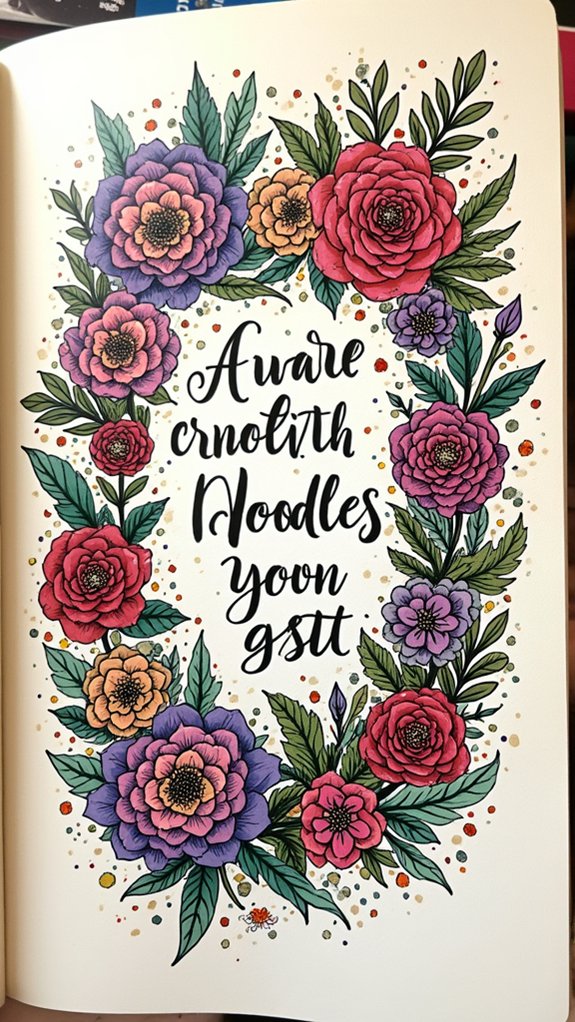
Picking a favorite quote for your sketchbook title page is like giving your art a pep talk every time you open it, so choose something that really fires you up.
Jazz it up with doodles and little drawings that match the vibe of your quote—think speech bubbles, lightning bolts, or whatever feels “so you.”
Try mixing funky fonts and bold lettering with your sketches to make the words and art blend together, creating a page that’s totally one-of-a-kind.
Choosing Meaningful Quotes
Ever wonder how one special quote can totally change the vibe of your sketchbook?
Choosing a quote that clicks with your artistic journey isn’t just cool—it can spark real inspiration every time you flip open your pages. Some artists even say the right words are like a creative secret weapon!
To make your title page memorable, try these ideas:
- Pick a quote from a favorite artist, author, or personal hero—someone whose words pump you up with inspiration.
- Play with different lettering styles or backgrounds to show off your personality. Don’t be afraid to go bold!
- Use sites like Pinterest for fresh ideas on cool ways to mix your quote with artsy doodles.
Decorating With Illustrations
Cool quotes are powerful all by themselves, but pairing them with bold doodles or colorful illustrations takes your sketchbook’s title page up a notch. It’s like giving your words a cool, artistic sidekick! Try drawing small icons, like paintbrushes, headphones, or even a slice of pizza—whatever matches your personality or the themes you plan to explore. Use vibrant colored pencils, markers, or watercolors to make the illustrations pop and truly personalize your space. Border your favorite quote with patterns or a bunch of silly doodles for extra flair. Here’s a handy table with some ideas to get your creativity flowing:
| Drawing Ideas | Illustration Styles | Personalize With |
|---|---|---|
| Flowers | Comic strip look | Hobbies (soccer ball) |
| Stars & Galaxies | Watercolor blobs | Favorite lyrics |
| Animals | Minimal line art | Zodiac sign |
| Mushrooms | Collage style | Lucky number |
| Geometric Shapes | Pastel palettes | Pet doodles |
Blending Words With Art
When artists blend words and art, the title page turns into something way more than just a space-holder—it transforms into a vibe-setter for the whole sketchbook.
A killer way to Fill The First Page is to pick a favorite quote and turn it into a mini piece of art. This doesn’t mean just scrawling the words and calling it done—oh no!
Here’s how anyone can mix things up with mixed media and a bit of creativity:
- Choose a quote that pumps you up or makes you smile, and write it using bold calligraphy or doodle-style letters.
- Doodle around the words—think stars, swirls, your favorite snacks—anything that screams “you.”
- Splash in mixed media with colored pencils, inky backgrounds, or even watercolor blots for extra flair.
Pattern Play Title Page
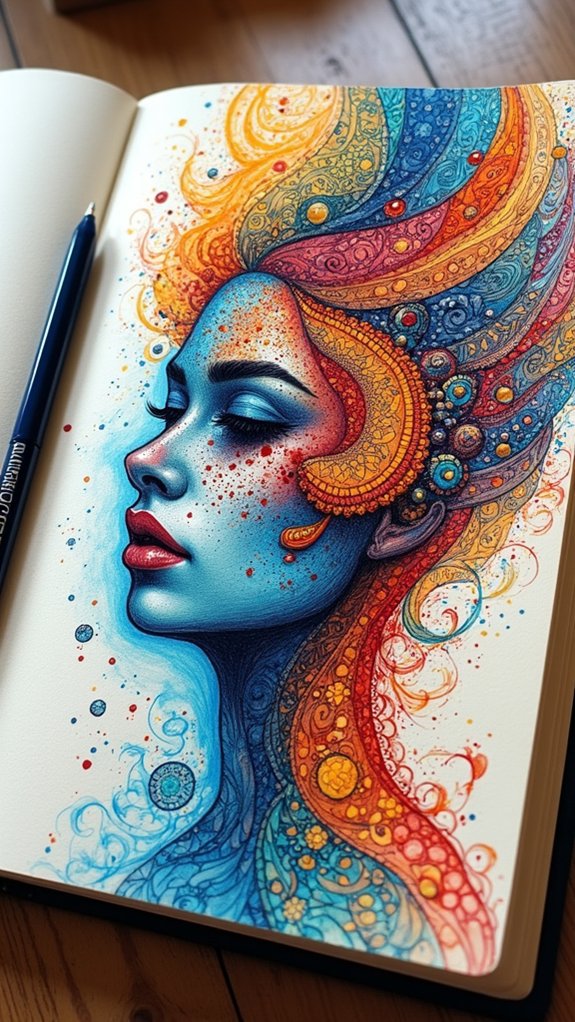
Although a sketchbook title page might seem like just a formality, “Pattern Play” turns it into a chance to show off serious creativity right from the start.
Imagine facing that blank page, a little nervous but excited, grabbing your favorite art supplies and getting wild with shapes and lines. Circles, triangles, wavy doodles—mix them together and suddenly, the title page isn’t so scary.
Colors and textures can burst across the page, hinting at the amazing stuff that’ll fill a book you poured your heart into. Fancy watercolor stripes? Bold marker dots? Go for it!
Mixing mediums creates eye-catching effects, and drawing patterns inspired by your style adds personality. Take clues from cool pattern designs or even leaves outside—anything can spark ideas for an epic page.
Collage of Inspirations
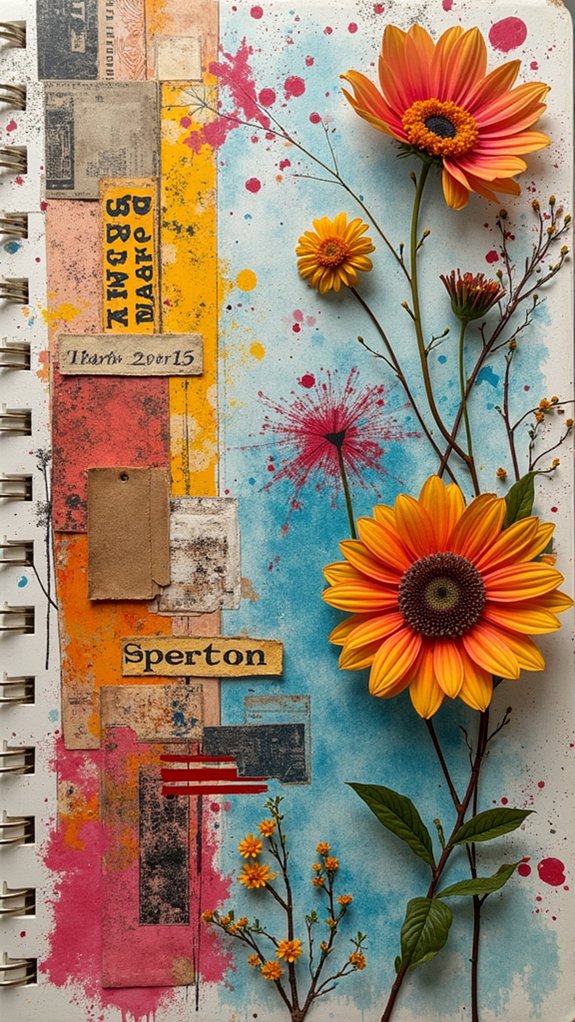
A “Collage of Inspirations” starts with gathering all sorts of cool visual bits—photos, magazine snippets, random wrappers, or even doodles from napkins—that just feel right.
Layering these pieces, maybe with textured paper or zany colors, adds a creative depth that makes the title page pop like a surprise party.
It’s almost like building a treasure map for all the creative adventures waiting inside the sketchbook!
Gathering Inspiring Visual Elements
Collages, with their wild mix of color and chaos, can turn an ordinary sketchbook title page into a total showstopper. To get started, it’s all about hunting down bold, inspiring visuals.
Whether it’s magazine clippings, photos, or doodles you made during math class (shh, we won’t tell!), each element adds life and personality. Don’t just grab anything—think about what vibes you want.
Keep things fresh by searching for textures too, like fabric bits or cool textured paper. Aim to:
- Collect a variety of images and materials that truly spark your imagination.
- Select a cohesive color palette to keep everything looking sharp and united.
- Find motivational quotes that are so good, you’ll want to read them every day.
Make your sketchbook title page unforgettable!
Layering for Creative Depth
Once all those inspiring scraps and colors are on deck, the real magic starts: building layers for extra flair and depth. This is where layering techniques come in, turning flat collages into stories that practically jump off the page!
By combining magazine cutouts, textured papers, doodles, or even snapshots of your cat, artists create awesome visual depth. Want that design to pop? Try contrasting colors or patterns. Feeling adventurous? Toss in some transparent overlays for a little mystery—hello, secret messages!
But don’t slap things down randomly. Think about composition and balance. Each element should add to your sketchbook’s vibe, not turn it into chaos. The goal: a title page packed with personality, clear focus, and a punch of creativity right at the start.
Theme Reveal Page
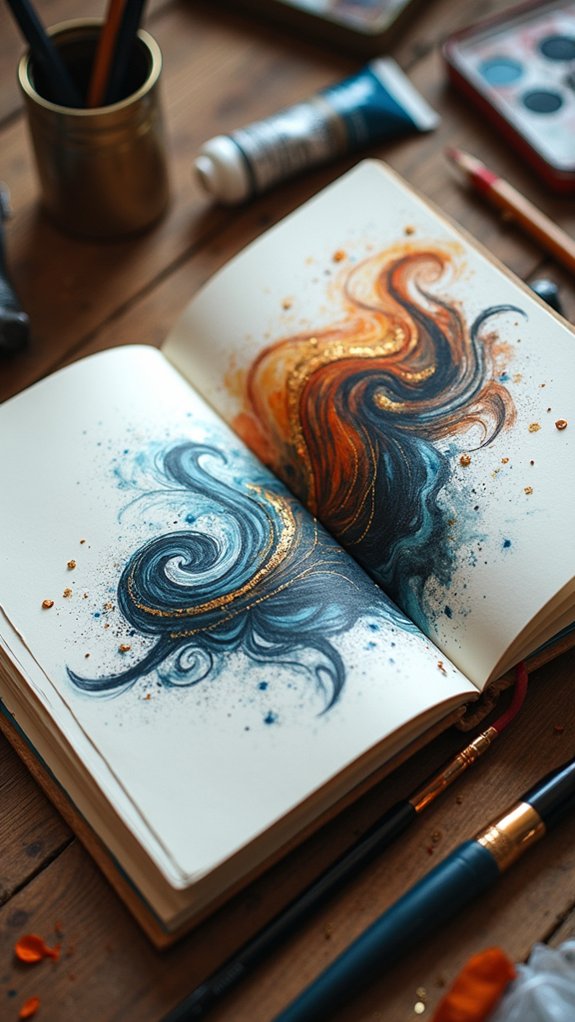
Nothing grabs attention quite like the very first page that shows off your sketchbook’s theme—it’s your chance to shout, “This is what I’m all about!” right from the start.
A theme reveal page sets the mood for everything that comes next, steering your creative process in a clear direction so you don’t lose steam halfway through. It’s like the trailer for your own creative movie!
To make your theme reveal page pop, try these ideas:
- Mix lively fonts and cool illustrations that match your vibe.
- Add a short blurb explaining your personal motivation for choosing this theme.
- Play around with colors, layouts, and symbols that scream “you.”
This page isn’t just decoration—it’s a bold statement that helps keep you focused and inspired!
Color Swatch Showcase
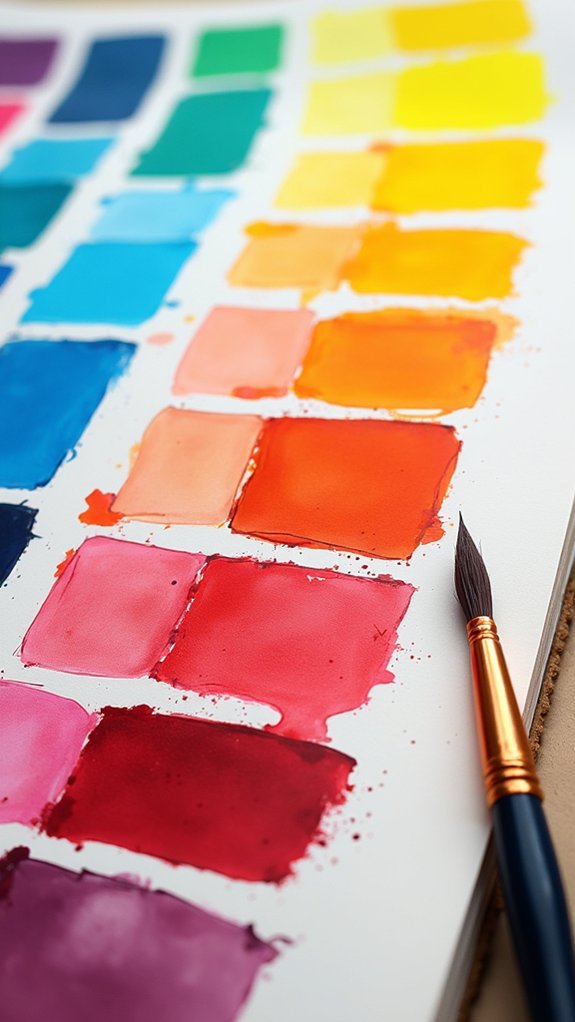
A color swatch showcase is a fun way to test out all your art supplies right on the title page—you get to see how markers, paints, or pencils look before using them for real.
It’s exciting to mess around with different color combos and create weird palettes you never would have thought worked together (magenta and mustard, anyone?).
Swatching isn’t just practical, it’s also like giving your future self a cheat sheet for picking bold, awesome colors in any sketchbook project.
Swatch Your Supplies
Even before the first doodle hits the page, anyone who loves drawing knows that picking the right colors can be half the fun—and half the challenge. That’s where taking time to swatch your supplies really shines.
Think about it: what better starting point could there be than a bold, rainbow-filled page of your sketchbook, packed with all your markers, colored pencils, and paints? It’s like making your own art supply menu!
Swatching isn’t just pretty—it actually helps you:
- See how colors really look on your page before using them in a drawing.
- Discover which supplies work best together or blend smoothly.
- Keep a handy color chart to grab inspiration fast.
Plus, it adds instant flair and personality to your sketchbook!
Color Palette Exploration
Why not kick things up a notch by turning the title page into a color palette playground?
Imagine the excitement of lining up a color swatch for each shade you love, arranging them by color families—warm, cool, or just plain wild. Testing out all your mediums, like watercolors, colored pencils, or even those neon markers you forgot you owned, can show you how each plays together on the page.
Jot down your top color combinations as you go. This not only looks fantastic, but it helps you spot your personal color palette before you even hit page two!
Plus, having those swatches handy means quick inspiration and fewer “ugh, that doesn’t match” moments in your future masterpieces.
Color chaos? More like color genius!
Experiment With Combinations
Dive right in and give that title page a splash of purpose by turning it into a color swatch showcase! Instead of just picking random colors as you draw, turn the first page into your very own experiment lab for color combinations.
This is so much more than just fun—you get to see exactly how your favorite markers, colored pencils, or watercolors mix and match on paper. Making a color swatch isn’t just about looks, either. It helps with planning smart and adding that wow factor to future art.
Here’s how to rock your color swatch showcase:
- Try out every art supply—see how ink, paint, and pencils layer together.
- Create organized rows to spotlight unique color combinations.
- Use it as an experiment spot to test new ideas anytime!
Yearly or Seasonal Focus Design

There’s something kind of magical about capturing a year or a season right on your sketchbook’s title page—it’s like bottling up a whole mood in just one spot.
Creating a yearly or seasonal focus design makes your sketchbook feel special, not just another blank book, but one with an artistic purpose. Imagine autumn leaves swirling across the cover, or frosty winter snowflakes setting a chilly vibe.
You can even play with different color palettes—warm reds and golds for fall, or icy blues and whites for winter. Add your goals or themes for the year or season to stay inspired.
Each time you open the sketchbook, that design nudges you back to your artistic dreams, keeping your creativity on track.
“Start Here” Adventure Map
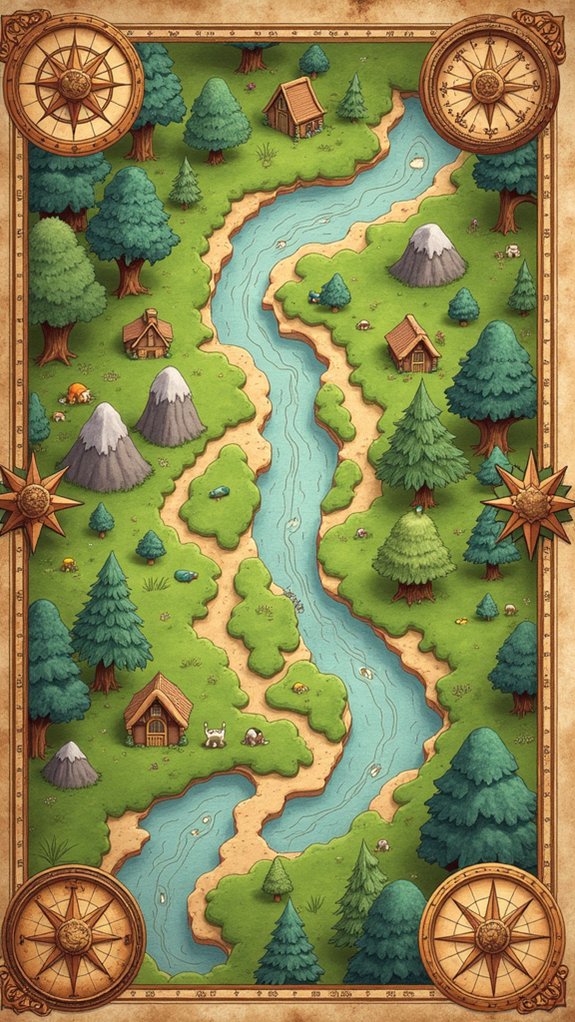
How does someone turn a plain old sketchbook into the start of something epic? It can all happen with a “Start Here” adventure map right on the title page! This map sets the tone for your entire creative journey.
Forget just drawing something boring—make it a wild exploration. Imagine arrows zig-zagging across the page with cool little landmarks and quirky icons that totally show off your personality.
To really grab attention, try these tips:
- Use colorful paths and popping textures so viewers feel like they’re *literally* stepping into your world.
- Place fun icons—like headphones, skateboards, or cats—for hints at what’s inside.
- Add motivation: make the title look like a quest so you’re pumped to fill every page!
Start your sketchbook adventure now!
Nature-Inspired Motifs
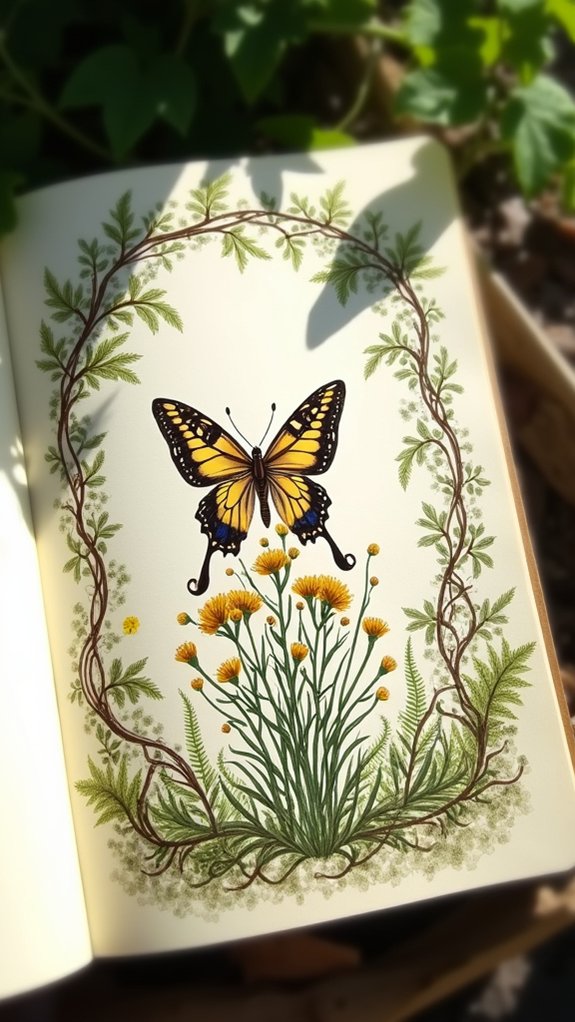
Nature-inspired motifs can turn a sketchbook title page into a little slice of the outdoors, right in your hands.
Imagine filling the edges with lively botanical pattern doodles or brushing in soft watercolor washes to create dreamy vistas—suddenly, your sketchbook looks like it grew on a tree!
Whether it’s tiny leaves twirling around your name or a misty meadow stretching across the page, these nature touches make your title page feel alive and totally unique.
Botanical Pattern Doodles
Botanical pattern doodles are like a secret code to the natural world, letting artists cover their sketchbook title pages with leafy branches, twirling vines, and cheerful blossoms.
These little drawings don’t just look cool—they actually make starting a new sketchbook way less intimidating. Plus, they give you a chill, almost meditative moment to doodle without rules or mistakes.
The real magic? Each nature-inspired mark can show off your personal style with every leaf and petal.
Want to jump in? Here’s how botanical pattern doodles boost your artistic exploration and creativity:
- Mix up different plant species to explore cool colors and shapes.
- Use patterns to set a relaxing or lively tone for your book.
- Experiment to discover your own nature-inspired doodling style.
Landscape Watercolor Washes
After doodling a forest of flowers and vines, some artists are ready to splash a little more color—and maybe splash it everywhere. This is where scenery watercolor washes come in, turning a plain page into a dreamy scene straight out of nature.
Whether it’s sweeping mountains, peaceful forests, or crashing ocean waves, these nature-inspired backgrounds steal the show. It’s not just about wild splashes, though—using the wet-on-wet technique makes colors flow into each other, soft and unpredictable, while dry brush lets you create streaky textures, kind of like wind in the trees.
Pick a few favorite colors for a cohesive vibe. Want more depth? Paint in tiny silhouettes, like a bird flying at sunset. Suddenly, your sketchbook whisper-launches into adventure mode!
Minimalist Modern Title Layout
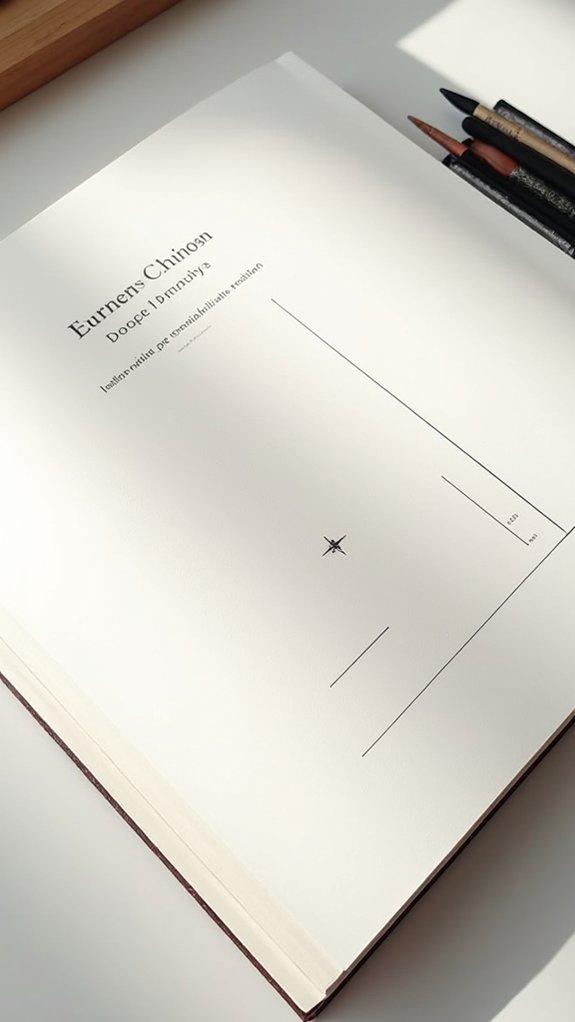
Sleek, simple, and kind of mysterious—the minimalist modern title layout is like the cool kid of sketchbook designs.
It’s all about clean lines and letting white space do the talking. Using a crisp sans-serif font, a touch of geometric shape, and maybe one bold line, the page gives off serious “I know what I’m doing” vibes—even if you don’t (yet).
Want that look? Go for monochrome, keep things unfussy, and let your high-quality paper be part of the design flex.
Consider these steps:
- Choose a classic sans-serif font and center your title for extra attention.
- Frame the title with thin, sleek lines or subtle shapes—think rectangles or circles.
- Leave generous amounts of white space to keep everything fresh and uncluttered.
Bold Hand-Lettered Title

Nothing says “Check out what’s inside!” quite like a bold, hand-lettered title splashed across the first page of a sketchbook.
This isn’t just about scribbling a name—it’s about grabbing attention and showing off some serious creative expression right from the start. Try out wild brush lettering or chunky block letters; don’t be afraid to mix things up until the look feels totally you.
Take it up a notch with decorative elements such as swirly flourishes, cool shadows, or outlines. Want it to pop even more? Use a color combo everyone can see from across the room!
Personalizing your page this way makes opening your sketchbook feel like cracking into an adventure. Plus, hand-lettering is a fun warm-up before diving into art.
Fantasy Worlds Gateway

A bunch of sketchbooks might start off ordinary, but a “Fantasy Worlds Gateway” title page instantly promises magic and adventure.
This isn’t just a cover—it’s like the front door into creative exploration, where dragons could lurk and castles float midair.
The best part? Your sketchbook becomes the launchpad for limitless imaginative environments.
Here’s how to make your title page pop:
- Draw a magical portal or gateway that says, “Step inside for something wild!”
- Use swirling fonts or hand-lettering and add quotes from your favorite fantasy books.
- Fill the page with tiny symbols—think dragon scales, enchanted keys, or glowing runes—to hint at all the incredible fantasy worlds waiting in your pages.
Imagination released, right from the start!
Abstract Expression Cover
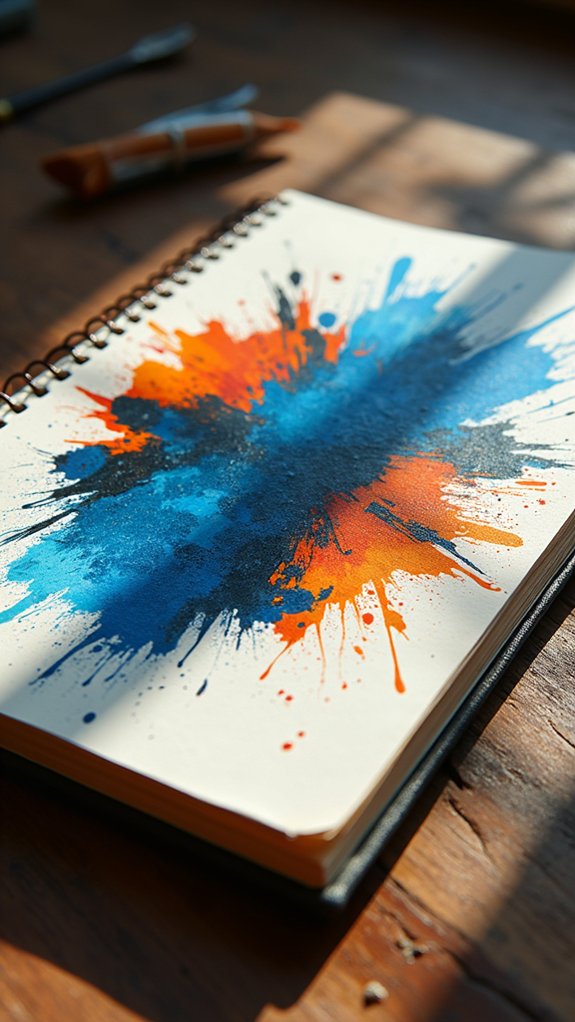
After wandering through realms of dragons and floating castles, it might feel wild to suddenly swap magic portals for a splash of pure energy on the page—but that’s exactly what an abstract expression cover is all about.
This style borrows from abstract expressionism, where feelings get painted louder than reality. Think bold colors, wild shapes, and surprises that leap out at you.
Using mixed media techniques, artists can layer paint, drip ink, or even stick on scraps of painted paper to build texture and depth. It’s like a mad scientist’s lab, but for art!
To make it personal, sneak in a few personal symbols or hidden doodles. Every brushstroke is a chance to show energy and personality, turning the cover into a true reflection of its creator.
Vintage-Style Scrapbook Intro
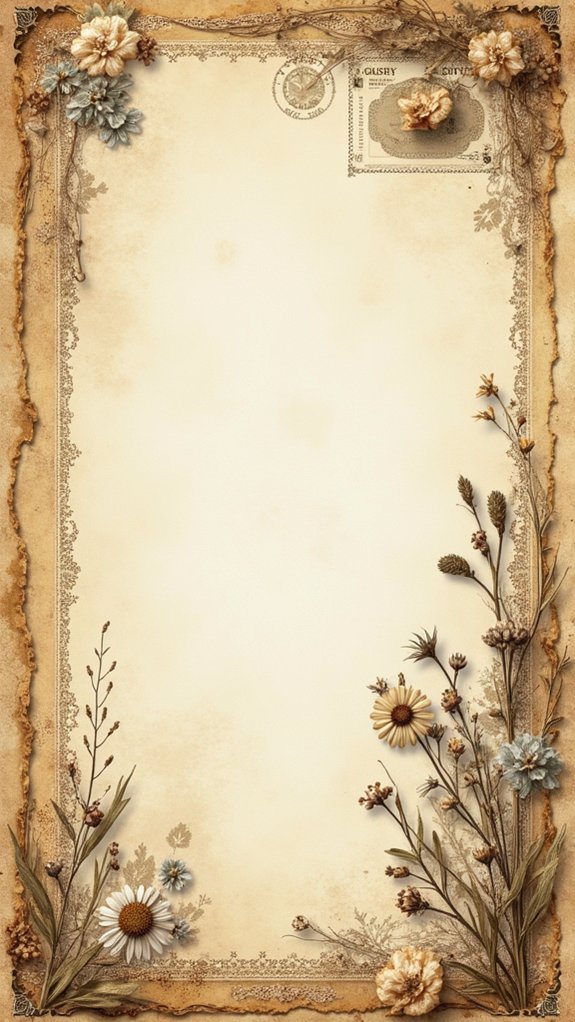
Even if someone has never rummaged through an old photo album or opened a dusty letter, bringing those cozy, time-traveled vibes to a sketchbook title page is easier than expected—plus, it’s seriously fun.
To set the scene for a creative journey, a vintage-style scrapbook intro relies on textures, colors, and classic flair that shout out “nostalgic feel!”
Here’s how anyone can nail this look:
- Use aged paper, lace, and sepia-toned photos for that perfect vintage-style scrapbook effect.
- Get fancy with ornate lettering, stamps, or stickers—bonus points for a quote in a retro font.
- Add a small pocket or envelope upfront; it’s great for tucking in little notes or personal keepsakes.
This warm, vintage vibe welcomes plenty of inspiration!
Portraits and Personal Icons
While some might think starting a sketchbook with a portrait sounds super serious, it’s actually a chance to have fun and show the real artist behind the pages. Self-portraits can be silly, moody, or totally wild—it’s all about showing who you are, your interests, and maybe even your weirdest expressions.
Personal icons, like your favorite animal, a soccer ball, or even a slice of pizza, let you mix in things you love. Trying different artistic styles—maybe realistic one day and super exaggerated the next—keeps things fresh and shows off your creative range.
Add pops of color or play with textures to make your title page stand out. Including small keywords or doodles adds even more personality and context, making your sketchbook unforgettable.
Hand-Drawn Typography Title
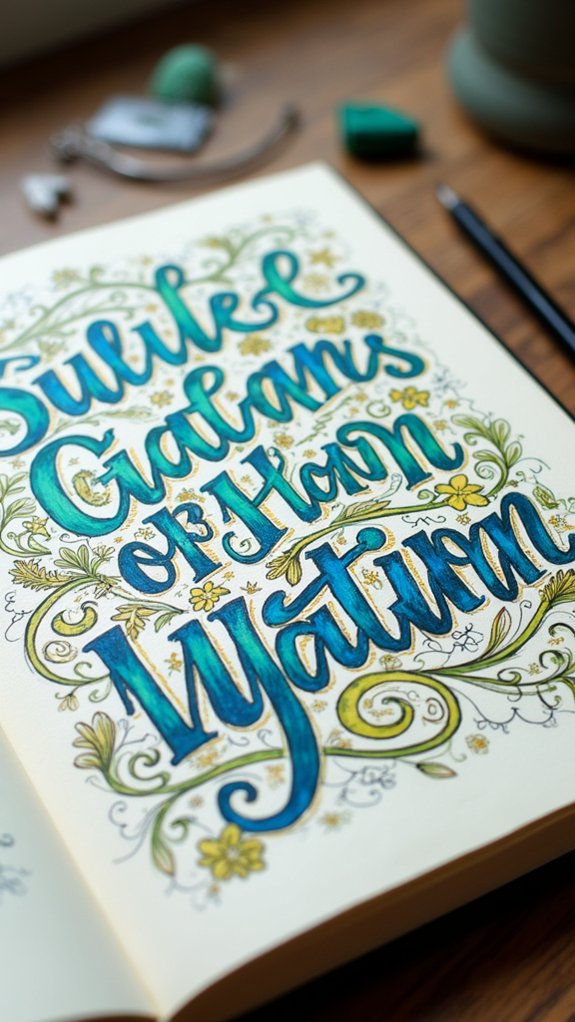
Lettering can totally set the vibe for a whole sketchbook before anyone even flips the page. Adding a hand-drawn typography title isn’t just about writing words—it’s about throwing your own unique expression right onto the cover.
There are so many cool directions to take, from swirling cursive to bold block letters, even funky doodle styles! If you’re thinking your title page needs a little pop, think about using different art tools, like colored pencils, markers, or even paint pens.
Want to crank it up a notch? Drop in some decorative elements—try flourishes, playful patterns, or mini-illustrations to pull everything together.
Here are three standout tips:
- Mix up lettering styles for fun new looks.
- Layer creative mediums for cool texture.
- Surround words with visual surprises.
Art Challenge or Prompt List
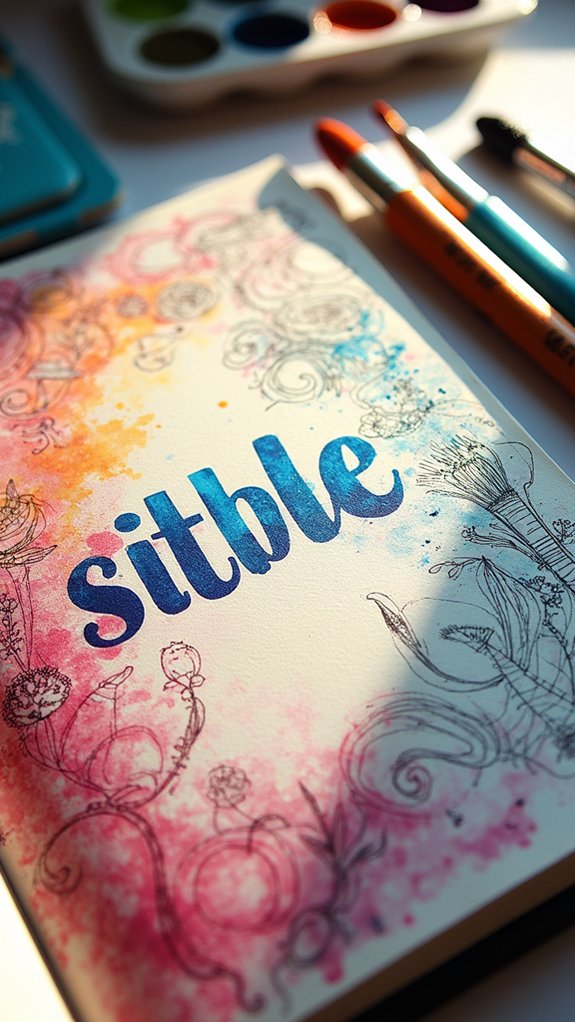
Sometimes, staring at a blank page in a brand-new sketchbook can feel like facing the world’s toughest boss level—except with pencils instead of magic powers. That’s where art challenges and prompts swoop in to save the day.
Filling your title page with a list of challenges, like Inktober or the 30-Day Drawing Challenge, kickstarts creative exploration and shakes off the intimidation. Imagine flipping open to see quirky prompts like “Draw your favorite animal” or “Create a piece inspired by a song.”
Even adding personal interests—nature, fantasy, wild dreams—makes it all feel like yours. Stacking up at least 10-15 varied prompts keeps things exciting and the ideas flowing. Plus, seasonal or monthly themes invite new inspiration year-round.
Victory released: boss level conquered!
Frequently Asked Questions
What Should I Put on the First Page of My Sketchbook?
When considering what to include on the first page, one might blend sketchbook inspiration, a creative title page, and a personal mantra. This combination sets tone, showcases individuality, and encourages ongoing artistic exploration throughout the sketchbook.
How Should I Start My Sketchbook?
Approaching a new sketchbook, one might begin by outlining sketchbook goals, drafting a personal manifesto, or compiling artistic inspirations. This reflective start can guide creativity, establish intention, and help navigate the initial uncertainty of blank pages.
What Should I Draw on My First Page?
When considering what to draw on a first page, one might combine inspirational quotes, personal symbols, or favorite colors. This approach allows for meaningful self-expression and sets the tone for creativity throughout the sketchbook journey.
How to Decorate the First Page of a Sketch Book?
When considering how to decorate the first page of a sketchbook, one might explore cover design ideas such as incorporating inspirational quotes, listing personal goals, and adding expressive visuals that reflect individual style, interests, and artistic intentions.
Conclusion
Starting a sketchbook can feel a little scary, but with these title page ideas, anyone can make their sketchbook pop right from the first glance. Whether it’s funny doodles, bold words, or a mini self-portrait, a strong start zaps new life into every page. Now, there’s no excuse for boring beginnings. Get a pencil, take a deep breath, and let your imagination totally take over. Who knows? This might just be the coolest sketchbook ever!


Leave a Reply